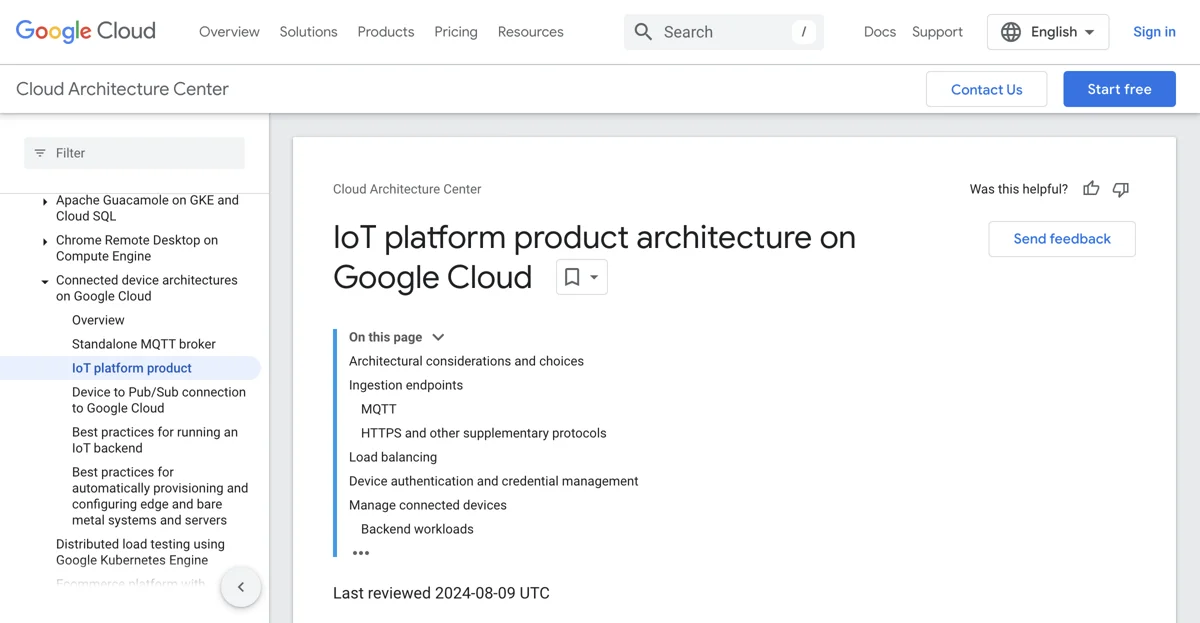The IoT platform product architecture on Google Cloud provides a unified interface for managing a diverse range of devices. It typically offers basic MQTT and HTTPS data connectivity, along with device provisioning, authentication, and management capabilities. Telemetry storage, visualization, data processing, and alerting are also part of its features. Organizations turn to IoT platforms when a standalone MQTT broker is insufficient. The platform deploys an MQTT broker or endpoint for device connectivity and is connected to an external proxy Network Load Balancer for traffic distribution. Additional IoT applications can connect through Pub/Sub or the Dataflow MQTT connector. The IoT platform provides various device management services, including device credential store, rules engine, device authentication and authorization, device configuration management, device registry, and device update management. It also often includes services like digital twin features, low-code development interfaces, alerting and notification capabilities, and other analytics functionality. When evaluating commercial IoT platforms, it's crucial to understand the approach taken for the MQTT endpoint implementation. Some platforms use a connector between MQTT and another message service, while others provide a full MQTT broker. HTTPS is a common alternative protocol to MQTT, with its own advantages and use cases. Load balancing considerations are similar to those in the Standalone MQTT broker architecture. Device authentication and credential management are key aspects, with various authentication methods available. Managing connected devices involves software and system updates, configuration updates, credential creation and management, and a rules engine for data processing. Backend workloads can be connected using common data transport and storage capabilities. Use cases where an IoT platform is a better choice than a standalone MQTT broker or direct connection to Pub/Sub include smart appliance management and logistics and asset tracking.

IoT platform product architecture on Google Cloud
Discover the powerful IoT platform product architecture on Google Cloud, offering seamless device management and more.

Top Alternatives to IoT platform product architecture on Google Cloud
ThingWorx
ThingWorx is an IIoT platform that helps industries transform digitally
ThingSpeak
ThingSpeak is an IoT analytics platform for data collection and analysis
IoT platform product architecture on Google Cloud
IoT platform on Google Cloud offers comprehensive device management
Particle
Particle is an AI-powered IoT platform for enhanced device management
OctoEverywhere
OctoEverywhere offers free remote access to OctoPrint, Klipper, and Bambu Lab printers, enabling users to manage their 3D printing from anywhere.
LatenceTech
LatenceTech offers AI-powered network latency monitoring solutions to enhance wireless network quality and reliability.
Insights Hub
Insights Hub is an AI-powered industrial IoT platform that helps businesses enhance manufacturing efficiency and make data-driven decisions.
Microsoft Azure
Microsoft Azure is a comprehensive cloud computing platform that offers AI and machine learning services to build innovative applications.
Azure IoT Hub
Azure IoT Hub is a cloud-based service that enables secure and scalable communication between IoT applications and devices.
Basemark
Basemark specializes in automotive AR software, enhancing driving safety and experience with real-time contextual guidance.
Nabto
Nabto is an AI-powered P2P IoT platform that enables secure, low-latency live streaming for smart surveillance cameras.
Currux Vision
Currux Vision develops autonomous AI systems for smart infrastructure, enhancing traffic monitoring and enforcement with edge and cloud solutions.
LensLink
LensLink offers innovative AIoT solutions for automatic image and video analysis, enhancing safety and business decision-making.
LeiaSR™
LeiaSR™ is an AI-powered technology platform that transforms 2D displays into 3D, offering immersive experiences on any device.
Campedia
Campedia is an AI-powered camera that identifies objects and answers questions through image recognition, powered by GPT-4 Vision.
xyzt.ai
xyzt.ai is an AI-powered platform that transforms IoT data into actionable insights through advanced spatio-temporal analysis.
Dairytech.ai
Dairytech.ai is an AI-powered dairy supply chain management solution that helps dairy farms optimize milk production, distribution, and delivery processes.
OpenALPR
OpenALPR is an AI-powered tool that simplifies automatic license plate and vehicle recognition, enhancing business capabilities and community safety.
Dubber
Dubber is an AI-powered conversation intelligence platform that helps communication service providers maximize network investment value.
YiIotCloud
YiIotCloud offers AI-powered video technology for home security and elder care, trusted by millions worldwide.
Devath
Devath is an AI-powered SmartHome platform that offers no-code device publishing and developer copilots to streamline app development.